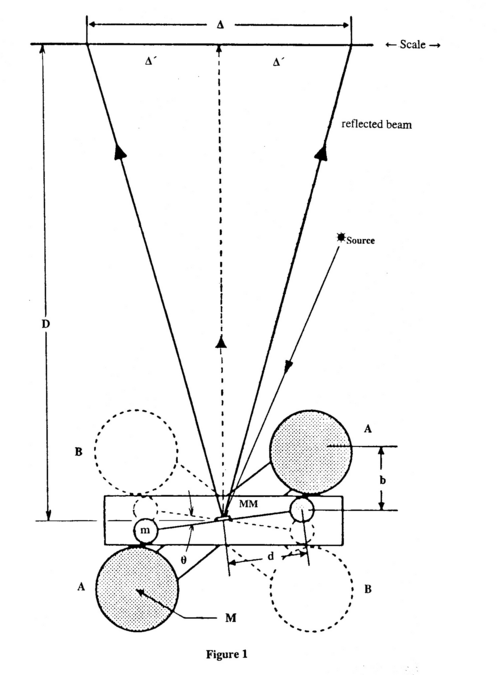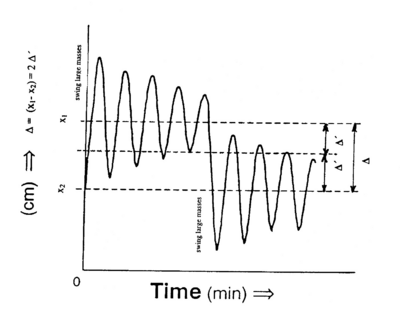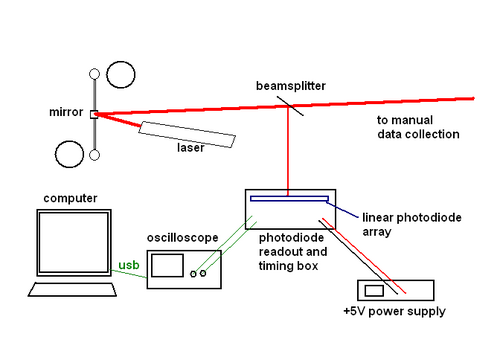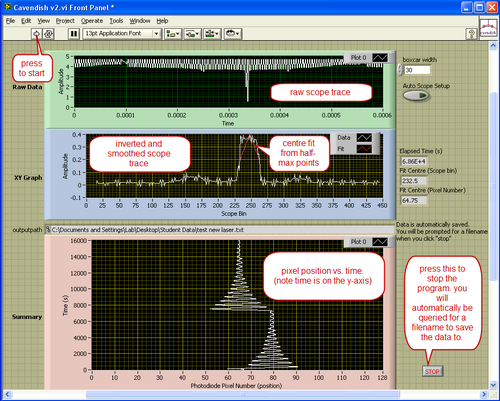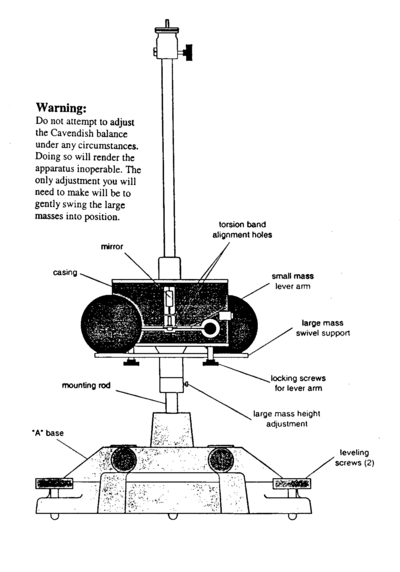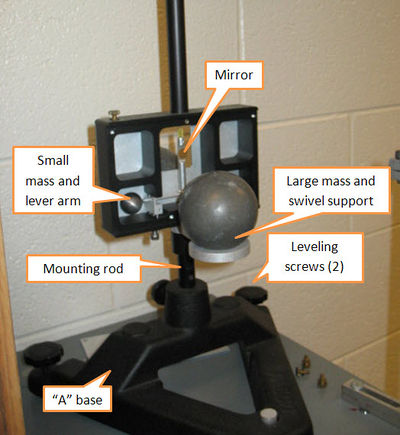Main Page/PHYS 3220/Cavendish
Contents
Measurement of the Gravitational Constant G with a Torsion Balance: The Cavendish Experiment
Introduction
Cavendish first performed the measurement of G, one of the classic experiments in physics, in 1798. Since then, there have been many attempts [1] to improve on this determination using variations of the same basic experiment. For example, see Gundlach[2] (2000) and Quinn[3] (2013). The apparatus at your disposal is a modified form of that used by Cavendish and others. The high sensitivity of the apparatus demands patience, perseverance and care from the experimenter. This is a very delicate instrument so treat it gently.
A laser S (see Fig. 1) illuminates a small (effectively) massless mirror MM that is attached to a light horizontal rod holding two small lead balls of mass m at a separation of 10cm. The small balls and mirror are suspended from a 25cm bronze torsion wire (perpendicular to the page). The entire apparatus is enclosed in a rigid case that is mounted securely on a wall or table.
When two massive lead balls (each with mass M = 1.5kg) are placed asymmetrically as illustrated, in position AA, a small torque acts on the torsion balance twisting the torsion wire and causing the image of the light source to swing through a measurable distance Δ' along the opposite wall. The swing gradually decays until equilibrium is reached. The massive balls are next placed at diametrically opposite points, BB, for further measurement. After the oscillations have died away once more, a second equilibrium position is reached at a distance Δ' with respect to the other side of the zero position. We will use this pattern to evaluate a value for G, the gravitational constant.
|
Figure 1 - Experiment setup (Top View).
|
Method
IMPORTANT: Treat the equipment gently. For example, slamming the door or bumping into the table will considerably lengthen the experimental observation time.
In order for the balance to operate correctly, the torsion wire must be precisely vertical and must be able to move freely. The centres of the four balls must lie in one plane as well.
Both a manual recording technique and a computerized data collection method are used in this experiment. The position of the laser beam on the graph paper on the opposite wall is noted when the heavy balls are an equal distance from the small balls. The large balls are then rotated so that they almost touch the case. You should make this adjustment carefully to ensure that the heavy balls do not knock the case. If the case is accidentally knocked, the mirror will be set into a large amplitude oscillation that will take about 1 hour to decay. You can therefore save yourself a lot of time (and effort) by making this adjustment delicately in the first place.
If this step has been completed successfully the position of the laser spot on the opposite wall will change slowly with time. Note this position on the graph paper every 15 seconds for the first few minutes and every 30 sec. or 1 min. thereafter. The light spot will undergo damped oscillations about an equilibrium position Δ'. Determine the mean period of oscillation P with a stop watch and compare this with the value derived from a plot of displacement vs. time. Allow about 45 min – 60 min for these oscillations to damp out and measure the new equilibrium position x1 (see Fig. 2).
|
Figure 2 - Graph of small-mass oscillations.
|
Carefully reverse the position of the heavy balls and repeat the procedure recording position vs. time and the new position at equilibrium x2. Now repeat this twice more and obtain an average value for Δ. Measure the diameter of the heavy ball and the thickness of the case. Find the separation of the centres of gravity of the two balls. What approximation(s) does this involve?
In this particular experiment, data will be collected by hand, and concurrently automatically by the computer. Part of the laser beam is reflected onto a 128-segment linear photodiode array. The output of the photodiode array is monitored on an oscilloscope, and a computer connected to the oscilloscope downloads the data for processing. A control program written in Labview collects and processes the data, so you obtain data points which form a graph similar to the manually collected data.
Theory
The torque generated by a force F acting on a mass m located at r is defined through the cross product T = r x F. For rotational motion in a plane described by an angle θ(t), angular velocity ω(t), and acceleration α(t) the torque has only a single non-zero component. It is perpendicular to the plane and is denoted by a scalar: T = Tz. The combination of the definition of torque with Newton's law of motion, and the moment of inertia I results in the equation of motion T = I α, where T represents the sum of all torques acting on the system (in our case two small masses rotating about their centre of mass). The external torque in our case is provided by the angular form of Hooke's law, as applicable for the torsion of wires, and we ignore for the moment the internal friction in the wire (which, however, is crucial to obtain a steady-state solution after long intervals).
If a torsion balance is twisted by a torque (couple) through a small angle θ (radians), the restoring torque is proportional to the angular displacement and is oppositely directed,
where C is the torque constant (cf. spring constant) of the wire. (What are the units of C?) We combine this with the equation of motion to obtain
| (1) |
Equation (1) is a homogeneous linear ordinary differential equation with constant coefficients. The friction responsible for the damping of the oscillations has been omitted here. Solve the equation and show that the period P is given by
| (2) |
Neglecting the material between the two small spheres, the moment of inertia I of the torsion balance about the axis of rotation is
| (3) |
where m is the mass of each ball and 2d is the distance between them.
Thus by measuring the period P and calculating I, the torque constant C may be found from equation (2). If Δ' is the deflection of the light beam from the rest position upon rotation of the torsion wire through θ radians, (Fig. 1) then
where D is the distance between the mirror and the recording medium.
Once the large spheres are moved to their alternate asymmetrical position, the total deflection Δ produced (after the oscillations have died out) is (see Fig. 2)
| (4) |
The torque (couple) exerted by the large masses is
| (5) |
Here F is the magnitude of the gravitational force of attraction between the small and large masses, and is given by
where b is the distance between the centres of the small (m) and large (M) masses at equilibrium.
Procedure
|
Figure 3 - Experimental Setup.
|
Data Collection
- Run the program "Labview 8.2", and open the vi called "Cavendish v2.vi".
- Turn on the oscilloscope and power supply only using the power buttons. The power supply should be giving +5V, and the settings should not be touched.
- To operate the laser, simply flip up the toggle switch of the laser power supply. The laser will appear a few seconds afterwards.
- When the program runs, it leads you through the steps of turning on the laser and power supply. Follow the directions carefully, as the program needs to obtain a background light level with the laser off.
- The data will be saved as two lists of numbers - one is the centre pixel number, and the other is the time. You need to convert centre pixel number to a displacement in order to calculate G.
|
Figure 4 - The Labview control program.
|
Parameters of Apparatus
| Diameter of large spherical mass | 6.386 cm |
| Diameter of small spherical mass | n.a. |
| Mass of large spherical mass | 1500g |
| Mass of small spherical mass | 20g |
| Thickness of Cavendish box enclosure | 3.01cm |
| Separation between the centre of the mirror and the centre of the small spherical mass | 5.0cm |
| Details of the Photodiode Array | |
| Number of pixels | 128 |
| Active area length | 10.2cm |
| Pixel size | 0.8mm x 0.8mm |
| Distance from mirror to photodiode array | 59.2cm ± 0.5cm |
Tasks
- Derive G from the above equations in terms of the period of oscillation.
- Discuss the effect of the attraction of the distant 1.5 kg. sphere for the small balls.
- Enumerate and discuss other possible sources of error in the measurement of G using this apparatus.
- When the beam of light oscillates about its final position, it slowly damps out. Assume that the damping force is proportional to the (angular) velocity to find the equation of the motion. From the data, find the damping constant. See textbook references on damped harmonic motion[4].
- Find the expression for the damping force at any time and compare the frequency of the motion without damping to that with damping. Comment on the difference(s) between the two.
- Why do you need to measure the period of oscillation?
- This experiment makes efficient use of real-time data acquisition and analysis. This is accomplished using the programming language LabView. What logical steps is the program following to convert what it downloads from the oscilloscope into a reasonable estimation of the photodiode pixel number which has has the laser? You will need to look at the "block diagram" of the program. (You can inspect the block diagram while the program is running). You are only required to understand the general algorithm, not the details. You may find [5] a useful starting point for understanding LabView.
|
Figure 5 - Cavendish Beam Schematic.
|
|
Figure 6 - Cavendish Beam.
|
References
- ↑ J.W. Beams, "Finding a Better Value for G", Physics Today, 24, 34 (1971)
- ↑ J.H. Gundlach & S.M. Merkowtiz, "Measurement of Newton's Constant Using a Torsion Balance with Angular Acceleration Feedback", Phys. Rev. Lett., 85, 2869 (2000)
- ↑ T. Quinn, H. Parks, C. Speake & R. Davis, "Improved Determination of G Using Two Methods", Phys. Rev. Lett., 111, 101102 (2013)
- ↑ For a discussion on damping see: A.P. French, Vibration and Waves, Norton, pp.62-70
- ↑ Getting Started with LabView
